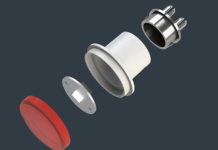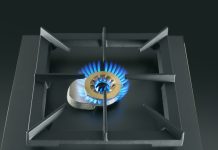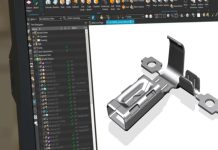The latest developments of metallurgy, driven by the applications in the automotive industry, in which the need of reducing the weight of vehicles is determining to limit consumptions, have revaluated the importance of stainless steel in the various market fields.
Roberto Papeschi
Steel, in its various typologies, is an alloy prevailingly composed by iron and carbon, with a carbon percentage not exceeding 2%. Due to its characteristics of mechanical resistance and easy machining, steel is largely used in the various productive sectors, especially in the manufacturing and construction industry.
The characteristics of the various types of steel and the developments of the metallurgy of these materials were illustrated to us in the course of an interview with Professor Silvia Barella, academic in the Department of Metallurgy and Non Metal Materials of Milan Polytechnics. As Mrs Barella tells us, steel is a material whose technology has been protagonist of a continuous series of developments for the whole last century and until nowadays, both concerning machining processes and the alloy composition.
As a matter of fact, to improve the material performances, other elements have been added to the basic alloy constituted by iron and carbon, among which first of all chromium, nickel, titanium, molybdenum and manganese. In particular, the addition of chromium in percentages indicatively exceeding 12-13%, already in the early years of the twentieth century had resulted in the production of stainless steels, characterized by high rust-free properties when exposed to air and water. This is due to a particular chemical process, called passivation, which forms a subtle layer of chromium oxide on the metal surface, with around 1-10 nm thickness, which prevents a further metal oxidation.
The technological innovations in the metallurgy of stainless steels, experimented for the first time at the beginning of last century and since then continuously perfected until nowadays, were conceived to satisfy a range of specific requirements of the metallurgy and construction industry, with the creation of alloys for special steels suitable for the most different applications. Research was anyway intensified in the last ten years, against the price trend of raw materials on the markets, restarting also the development of solutions that were already known theoretically but that had not found any industrial outlet.
Important experimentations were then carried out also in the machining field, such as the recourse to asymmetric rolling processes, where the two cylinders of the rolling mill rotate at different speed. In this case, whose applications are still under study, severe plastic deformations of the material are generated, with the result of obtaining small-grain crystalline structures, which therefore confer superior mechanical features to the steel treated in this way. Notable results have been obtained also in the field of junction methods, including laser welding, very important for the creation of metal structures with differentiated resistance.
The automotive industry requirements
Stainless steels were protagonist, in recent times, of a real technological revolution mainly driven by the automotive industry, which is the major user of special steels together with the machine tool industry. The target was to obtain, besides a lower cost and easier material provisioning, a lower weight of vehicles, better mechanical resistance and improved capability of dynamic energy absorption in case of collisions.
In particular, the reduction of the vehicle weight is today one of the needs most felt by the car industry, in a time in which the reasons connected with the shortage of resources and the environment protection have resulted in severe regulations on a world scale. Especially the European Union has imposed strong limits, issuing various directives on this matter and also providing for harsh economic sanctions for the automotive companies that do not comply with determinate limits of noxious gas emission.
In that context, some producers have preferred adopting aluminium bodyworks, whose specific gravity is much lower than steel’s, in order to reduce notably the car weight and then the fuel consumption. But this solution implies some inconveniences, especially those connected with the low mechanical resistance of aluminium structures and the scarce protection of the passenger compartment in case of accidents, owing to the modest absorption of the dynamic energies that are developed during the collision.
compartment in case of accidents, owing to the modest absorption of the dynamic energies that are developed during the collision.
Concerning this, it is worth underlining that, in case of crash, some austenitic steels absorb dynamic energy, not only in their phase of mechanical deformation, but also because of a physical modification of the material itself. The absorption due to shape modifications, in fact, is added to further energy absorbed in virtue of the transformations of the particular crystalline structure of the austenitic steel as a consequence of the stresses to which the metal structure is subjected.
These considerations have led car designers to prefer steel again rather than the use of alternative materials, also because in the meantime outstanding developments had been achieved in the steel metallurgy, thanks to the experimentation of ultra high-strength alloys. Moreover, the use of advanced assembly technologies of different materials, joined one another with innovative welding systems, have allowed implementing composite metal structures, with differentiated resistance.
These structures, economically competitive, provide for the use of high strength steels only in the points affected by the major stresses, while the parts undergoing lower stresses can be manufactured with cheaper steels. These same solutions have then found application also outside the automotive sector, in particular in the household appliance industry, where stainless steels are largely used not only due to their characteristics of machinability and high mechanical and corrosion resistance, but also for the easy cleanliness and the hygiene of surfaces, as well as for the esthetical quality that these materials allow achieving.

The performance oversizing
Stainless steels, depending on their composition, can be subdivided into different families, among which the most widespread are those constituted by austenitic and ferritic steels. In particular austenitic steels, whose alloy contains about 17% of chromium and a nickel quantity exceeding 10-12%, constitute the prevailing part of the world production of stainless steels and stand out for a high resistance to corrosion and oxidation, both cold and hot, as well as for a good weldability. It is also worth underlining that further increases of chromium and nickel, compared to the indicated values, favour the cold forming of the material, as required for instance in deep drawing machining and in forming with low bending radii.
We should anyway notice that, against the excellent features of austenitic steels in terms of mechanical resistance, resistance to corrosion and cold machinability, a limit to their use is represented by the high cost and by the scarcity of nickel with which these alloys are made. Not only, in fact, the price of the nickel has underwent a very strong rise in the last ten years but is also subjected to relevant price fluctuations on the market, which make its provisioning problematic.
For these reasons, a re-evaluation of ferritic steels is in course, since they are less expensive steels and characterized by less difficult provisioning, due to the absence of nickel in this alloy typology. On the other hand, today it is in course the critical analysis of the performances really needed in the different applications by product designers. They have then discovered that for numerous applications, as in the case of the household appliance industry, the specifications of austenitic steels are oversized compared to the real needs of products, both in terms of mechanical resistance and of resistance to corrosion.

The rediscovery of ferritic steels
The use of ferritic steels, cheaper and with more stable market prices than austenitic ones, was anyway limited in the past by some contraindications, and among them one of the most important was represented by the fact that in a standard ferritic steel, as consequence of the heat induced by welding, chromium carbides were formed with localization in the contiguous zone to the welding itself, with the result of diminishing in that zone the percentage of free chromium, which is the main anticorrosion agent.
But they have recently found a remedy to this phenomenon by discovering that the addition, in small percentages, of niobium and titanium in the composition of a ferritic alloy notably improves the resistance to corrosion of these steels, especially in the thermal altered area. As a matter of fact, with the addition of small quantities of niobium and titanium, with which carbon has a higher binding affinity compared to chromium, not only it is possible to avoid or to reduce this phenomenon remarkably but at the same time the machinability characteristics of ferritic steels are improved, in particular concerning cold forming.
The successful cases in the applications of stainless ferritic steels are numerous and among them it is sufficient to remind the production of exhaust systems of cars and the drums of washing machines. Concerning exhaust systems, we highlight that these products undergo high operation temperatures as well as very corrosive environmental conditions. In this case, just the use of ferritic stainless steels has permitted to extend the warranty periods of these elements.
In their turn, washing machine drums, which operate in wet environment and in contact with detergents, constitute a case in which the formation of rust is favoured but this is not absolutely accepted by users. The long service life of exhaust systems of cars and of washing machine drums, both manufactured today with ferritic stainless steel, demonstrates the full validity of the use of this material, which has surpassed austenitic steels not only for the lower cost but also for the easy machining.
Ferritic steels, in fact, even if to a more limited extent than austenitic steels, are as malleable as carbon steel and for this reason they are suitable for the majority of forming operations, permitting to implement the most complex geometries. Besides, they are characterized by high conductivity and low thermal expansion, by high yield strength and by discrete traction breaking load. Due to the whole of these specifications, ferritic stainless steels find applications in a wide range of products, not only in the automotive industry but also in the household appliance one, including washing machines and dishwashers, gas cookers, cooking hobs, suction hoods and microwave ovens, as well as for the production of small appliances, saucepans and other household items.
Welding processes
 The availability of a plurality of steels, with different features and costs, has paved the way to the realization of mechanical structures with differentiated resistance, springing from the junction of more parts with different characteristics. For this reason, the junction processes of mechanical elements have become decisively important for the implementation of structures characterized by performances that meet, in each of their points, the real application needs and that are economically advantageous compared to standard monolithic solutions, made of homogeneous material.
The availability of a plurality of steels, with different features and costs, has paved the way to the realization of mechanical structures with differentiated resistance, springing from the junction of more parts with different characteristics. For this reason, the junction processes of mechanical elements have become decisively important for the implementation of structures characterized by performances that meet, in each of their points, the real application needs and that are economically advantageous compared to standard monolithic solutions, made of homogeneous material.
Among the junction processes of mechanical elements, the absolute highest importance is deserved by welding systems among which, besides standard arc welding systems, those based on ultrasound, electronic beam and laser technology stand out for their innovative aspects. Mainly the latter have been the focus of the most interesting developments from the industrial point of view, which have led to produce “penetration laser welding” systems.
This technology provides for laser sources featuring high power, over 106 W/cm2, able to provoke the vaporization of a small cylindrical portion of material, thus forming a capillary penetration hole, called “keyhole” surrounded by a layer of melted material that tends to enclose the capillary itself. Under adequate conditions, it is possible to realize a stationary situation between the laser beam and the piece to be welded, kept together in relative motion, with a speed that allows the production of a sufficient quantity of steam to maintain the formation of the capillary hole.
The cavity reaches a very high temperature, in the order of 20,000 °C, transmitting the heat from the hole walls towards the outside, unlike conduction welding where the heat propagates in inverse sense, from the outside to the inside. By opportunely regulating the relative speed between the piece to be welded and the laser beam, the “keyhole” translates along the joint progressively melting new material, which solidifies immediately after with the hole advancement. Worth noticing that it is possible to use both a continuous and a pulse source as laser source. In this second case, a single pulse forms the “keyhole” that immediately closes in the successive rest period and is formed again with the new laser pulse emitted after the piece translation.
For both welding types, with continuous and pulsed laser, a characteristic of laser welding processes is represented by the rapidity of heating and cooling of the material, with a minimal delivery of thermal energy in the welding zone. Under these conditions you create a deep, clean and reduced weld bead, with a reduced extension of the zone thermally altered and higher junction quality than the one attainable with other welding processes. Other advantages of the laser technology, compared to other systems, are the easier welding of heterogeneous materials, together with a high welding speed and optimal working flexibility, also turning to automated systems.





